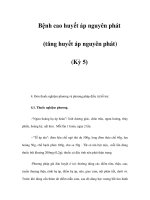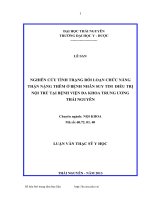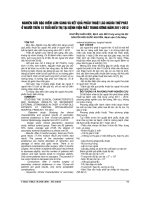Rung nhĩ ở người bệnh suy tim điều trị năm 2014 có gì mới
Bạn đang xem bản rút gọn của tài liệu. Xem và tải ngay bản đầy đủ của tài liệu tại đây (2.08 MB, 37 trang )
Management of atrial fibrillation in
patients with heart failure:
what's new in 2014?
Dr. Reginald Liew
MA, MBBS (Hons), PhD (Lond), FRCP (UK), FESC, FACC
Senior Consultant Cardiologist, Gleneagles Hospital
Asst. Prof. Duke-NUS Graduate Medical School, Singapore
No conflict of interests to disclose
Outline of talk
• Incidence/ Pathophysiology of AF in patients with
heart failure
• Rate versus rhythm control
• AVN ablation and PPM/ CRT insertion
• Catheter ablation of AF in heart failure patients
• HF with impaired LV function
• HF with preserved EF
Outline of talk
• Incidence/ Pathophysiology of AF in patients with
heart failure
• Rate versus rhythm control
• AVN ablation and PPM/ CRT insertion
• Catheter ablation of AF in heart failure patients
• HF with impaired LV function
• HF with preserved EF
Prevalence of AF in patients enrolled
in HF studies
• AF is very common in patients with heart failure
• Incidence is around 20-50% from heart failure studies
Hazard ratios of shared risk factors in
patients with AF and heart failure
Trulock et al. JACC. 2014; vol. 64, no. 7
Pathophysiological relationship between
AF and heart failure
Trulock et al. JACC. 2014; vol. 64, no. 7
Treatment options for AF in patients
with heart failure
1. Control ventricular rate
•
Beta-blockers, Ca- channel blockers, digoxin
2. AVN ablation and insertion of PPM/ CRT device
3. Restore SR (if persistent AF) with DC
cardioversion + AAD
4. Catheter ablation of AF
• Stroke prevention with oral anticoagulation
Outline of talk
• Incidence/ Pathophysiology of AF in patients with
heart failure
• Rate versus rhythm control
• AVN ablation and PPM/ CRT insertion
• Catheter ablation of AF in heart failure patients
• HF with impaired LV function
• HF with preserved EF
Rate v Rhythm control in heart failure
patients with AF
• No study has shown an overall survival benefit of either strategy
– e.g. RACE, AF-CHF, ANDROMEDA, AFFIRM, DIAMOND, CAFÉ II
• However, the trials tested treatment strategies and not true rate v rhythm
control
– Substantial cross-over between treatment arms
– Improved QoL in patients who remained in SR
• Newer drugs are being studied (e.g. ranolazine- Na Channel blocker) and
possible future role for genetic test in best choice of drug (e.g. genotypedirected bucindolol therapy in HF and AF).
• Pts with AF and structural heart disease have limited choice of AAD due to
toxicities and risk of TdP
Lenient v strict rate control in AF
Van Gelder et al. NEJM 2010;
362(15):1363-73
•
614 pts with permanent AF
randomly assigned to:
•
•
•
•
Lenient rate control (<110bpm
at rest)
Strict rate control (<80bpm at
rest; <110bpm during
moderate exercise)
Easier to achieve target HR in
lenient group
No difference between
symptoms and adverse
outcomes between the two
groups
• Post-hoc analysis of RACE II in heart failure patients (LVEF<40%): stringency of rate
control has no effect on cardiovascular morbidity and mortality, symptoms or QoL
•
Mulder et al. Eur J Heart Fail 2013; 15(11): 1311-8
Meta-analysis of beta-blocker for rate
control in heart failure patients with AF
HF and SR
HF and AF
• Large meta-analysis of data from 10 RCTs (18,254 pts)
• Beta-blockers have no survival advantage or benefits on reduced hospital
admissions in HF pts with AF, unlike their beneficial effects in HF patients in SR
Kotecha et al. Lancet 2014 (in press)
Outline of talk
• Incidence/ Pathophysiology of AF in patients with
heart failure
• Rate versus rhythm control
• AVN ablation and PPM/ CRT insertion
• Catheter ablation of AF in heart failure patients
• HF with impaired LV function
• HF with preserved EF
Major studies of AVN ablation and
CRT for patients with heart failure
Ganesan et al. JACC 2012, vol 59: 719-26
Major studies of AVN ablation and
CRT for patients with heart failure
Ganesan et al. JACC 2012, vol 59: 719-26
Improved survival in pts who
underwent AVN ablation and CRT
All- cause mortality
Cardiovascular mortality
Ganesan et al. JACC 2012, vol 59: 719-26
Improvement in NYHA class in patients
undergoing AVN ablation and CRT
Ganesan et al. JACC 2012, vol 59: 719-26
Outline of talk
• Incidence/ Pathophysiology of AF in patients with
heart failure
• Rate versus rhythm control
• AVN ablation and PPM/ CRT insertion
• Catheter ablation of AF in heart failure patients
• HF with impaired LV function
• HF with preserved EF
Catheter ablation of AF in HF
Advantages
Disadvantages
– Alters atrial substrate to treat disease
– Invasive with 2-4% complication rate
– Improvement in quality of life and
symptoms
– Long procedure
– More effective than AADs; may be
able to come off AADs
– Pts often have multiple co-morbidities
– May require multiple procedures
– May not be cost-effective
Approaches to catheter ablation in
AF and heart failure
Trulock et al. JACC. 2014; vol. 64, no. 7
AP n PA View of Ablation Spots on PV veins and Roof
CFAE lesions in yellow
RIPV isolation
Major trials of AF ablation in patients
with heart failure
Trulock et al. JACC. 2014; vol. 64, no. 7
Major trials of AF ablation in patients
with heart failure
Trulock et al. JACC. 2014; vol. 64, no. 7
Jones et al. JACC, vol 61, no. 18, 2013
Primary endpoint
Significant improvement
in peak VO2 (measure of
exercise capacity) in
ablation group after 12
months follow up
Jones et al. JACC, vol 61, no. 18, 2013









